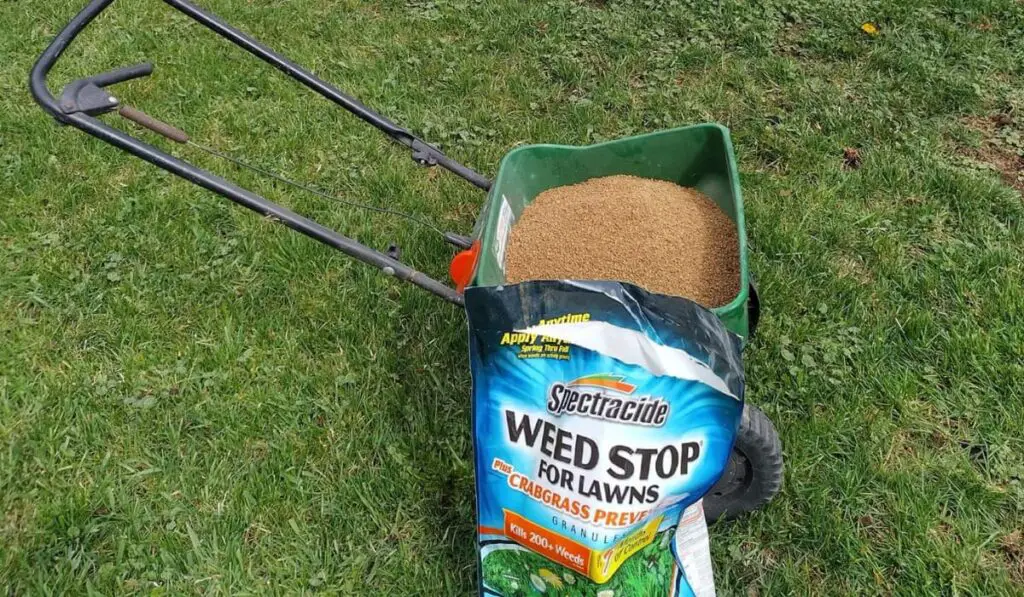We all know how troublesome weeds can be, especially on lawns. It can be frustrating and time-consuming to uproot them one by one. So, how do you get rid of lawn weeds? A simple answer to this question is to use the Spectracide weed stop.
Spectracide Weed Stop is a herbicide that kills unwanted plants by stopping the growth of their root systems. This selective herbicide helps control chickweed, dandelion, crabgrass, and foxtail, among other lawn weeds.
Contents
- 1 How Does Spectracide Weed & Grass Killer Concentrate Plus Work?
- 2 How To Use Spectracide Weed Stop
- 3 When To Use Spectracide Weed Stop
- 4 What Are the Benefits of Using Spectracide Weed Stop?
- 5 Is Spectracide Weed & Grass Killer Concentrate Plus Safe for Pets?
- 6 Tips for Using Spectracide Lawn Weed Killer
- 7 Bottom Line
How Does Spectracide Weed & Grass Killer Concentrate Plus Work?
Spectracide has powerful chemical properties that kill weeds by disrupting their cellular structures. It combines four active ingredients, 3.74% 2,4-D, dimethylamine salt, 1.79% Quinclorac, 0.43% Dicamba, dimethylamine salt, and 0.22% Sulfentrazone.
When sprayed onto a lawn, the weed leaves absorb the chemicals, move them down to the roots, and tamper with the cellular structures, eventually killing them.
How To Use Spectracide Weed Stop
Despite being a powerful weed killer, Spectracide Weed Stop is trouble-free to use. It is designed to make it easy for homeowners to apply without requiring a spreader or tank mixing.
First, determine the lawn size. To do so, use a tape to measure the length and width and multiply them to obtain the square feet.
Secondly, determine the amount of herbicide that’ll suffice the measured area. Most Spectracide treatment ingredients are based on 250 sq. ft. sections, so you should divide the total area by 250 to find the amount of chemical and water needed.
Typically, a 32 oz bottle should cover an area of approximately 5,000 sq. ft. You must go through the usage instructions keenly to stay on the right track.
Put on a protective mask, eyewear, rubber gloves, long pants, long-sleeved shirts, socks, and shoes. Also, ensure no children or pets are in the vicinity until the chemicals have dried.
Mix the chemicals with the appropriate amount of water required. This is a crucial step because the concentration level is a key determinant of how effective the herbicide will be. After calculating and achieving the appropriate Spectracide concentrate mix ratio, close the sprayer and mix the solution thoroughly by shaking.
However, some Spectracide Weed Stop herbicides come as ready-to-spray chemicals. Ensure to read the label comprehensively before diluting in water.

When To Use Spectracide Weed Stop
To kill the weeds completely, spray Spectracide when they are still young. This is essential because the plant cells are actively growing, and the chemicals can take advantage of soil moisture to improve absorption.
Spectracide works best if applied during the daytime when the temperatures are between 45°F and 90°F (7°C and 32°C). Spraying during the fall will keep the weeds dormant throughout winter and may resprout in the spring season.
If you are controlling hard-to-kill weeds or weeds on a pasture with heavy grass, you should spray again at the same rate after two weeks, or else they’ll only wither and grow back. It’s because a heavy grass cover may tolerate herbicide resistance.
What Are the Benefits of Using Spectracide Weed Stop?
The benefits of using Spectracide Weed Stop are manifold:
- Spectracide kills weeds instantly. You will notice visible results within 3 to 5 hours when you use it as directed. Other weeds, such as crabgrass, may take up to two weeks before they die.
- Spectracide harms the weeds without affecting the lawn.
- Spectracide harms the roots, meaning it totally destroys the weeds.
- A single spray of Spectracide can kill over 460 types of weeds.
- Spectracide gets rid of the hard-to-kill crabgrass.
- Spectracide is rainproof in 3 hours – if it rains three hours after you spray, it won’t wash away its effectiveness.
- Spectracide Weed Stop can be applied to both cool and warm season grass.
Is Spectracide Weed & Grass Killer Concentrate Plus Safe for Pets?
Ingestion of Spectracide may cause temporary problems like irritation, vomiting, and tremors. The same applies to humans. These effects may start to show within the first hour of contact.
It is advisable to remove all pets when spraying the Spectracide weed killer. Wait until the herbicide has dried before allowing pets to roam on your lawn.
Also, ensure you don’t apply within 25 ft of fish ponds, rivers, streams, bays, and oceans. Avoid spraying to the point of run-off or when it’s likely to rain since the chemicals might get washed away to water streams and endanger animal and human lives.
Tips for Using Spectracide Lawn Weed Killer
If anyone tells you Spectracide weed grass killer doesn’t work perfectly, it’s because they aren’t doing it right.
Here are tips on using Spectracide weed and grass killer for top results:
- Timely spraying is critical. Spray when the weeds are actively growing, which is commonly the growing season.
- Do not spray drought-stressed lawns
- You must adjust the spray nozzle to produce a coarse spray since fine mists are more likely to drift.
- Mow the lawn two days before spraying, especially if the grasses are tall.
- Avoid overapplication.
Bottom Line
Spectracide Weed Stop is an excellent herbicide for lawn weeds, but most people fail to realize it because they don’t follow the recommended steps when applying it. Failure to do so may result in the destruction of lawns, or the weeds may not die at all.
Remember to buy the correct type of Spectracide, read the instructions on its label, and spray while following the best practices. Good luck with weed control.